Located 450 kilometres (280 miles) east of Paris, along the river Rhine, the “Alsace wine route” is a designation created in 1953 by the winegrowers eager to share their love for their beautiful land. On a distance of 170 kilometres from Thann (northwest of Mulhouse) to Marlenheim (northwest of Strasbourg), this route displays so many villages (almost 100) that it is called the “thousand villages” region. The perfection of the wines, the charm of these villages as well as the kindness of the local people are definitely worth a few days visit.
Although less famous then Bordeaux and Burgundy, the Alsace vineyards are among the oldest in France.
French and German cross culture is presented here through the architecture, food and wine of this fairytale land of castles, costumes and distinctive wines. In this show we present the oldest wine in the world, a traditional family style vineyard, a look at Alsatian Riesling, Gewurztraminer, Muscat; a visit to the Chateau du Haut Koenigsbourg, the second most visited tourist location in France after the Palace of Versailles, the preparation of the Baeckoffe casserole and a touch of wine folklore.
Wine tourism is a tradition that has long existed in Alsace, and many villages along the region’s famous wine route celebrate the end of the grape harvest with wine festivals throughout October – there are very good ones in Eguisheim and Turckheim this weekend.
The route also turns 60 next year, and no part of France can compare when it comes to the warm welcome wine lovers receive when they visit the vineyards and picturesque villages here. You can find charming B&Bs, often run by the vignerons themselves, rarely costing more than £50 for a double room with breakfast. Alsace cuisine is distinctive compared with that of the rest of France, and pairs perfectly with the characteristic wines produced here – riesling, gewürztraminer, sylvaner and pinot noir. Every village high street is lined with wine cellars offering tastings.
WINEMAKERS TO VISIT
Domaine Paul Blanck et fils
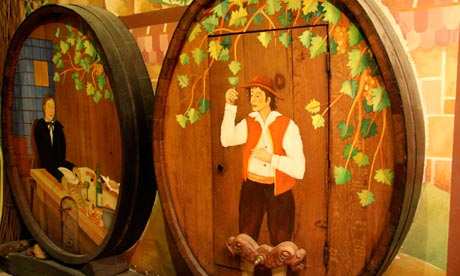
To begin to understand the complex world of Alsace wines – the grapes, the difference between a simple sylvaner and a grand cru riesling – start off with a basic tasting in the wine cellar of a vigneron, who will always passionately explain his vineyard. There is no better address to start than Domaine Paul Blanck, a family dynasty that not only produces superb wines, but has a long history of ensuring the quality and recognition of Alsatian appellations around the world. After 400 years of experience, the current winemaker is the down-to-earth Philippe Blanck, who comes straight to the point when asked about his wines; “Tell your readers to call first to make an appointment, the genuine way of meeting and exchanging views with the winemaker. Visitors here need to do three things: see our fabulous vineyard landscapes, try the wine with the winemaker himself, then ask him where to go and eat, as our wines are best when you taste Alsatian cuisine at the same time.”
• 32 Grand’rue, Kientzheim, +33 3 8978 2356, blanck.com
Maison Emile Beyer
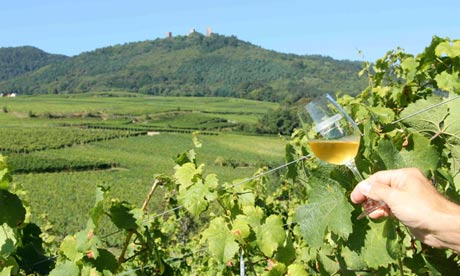
Wine has been made in the rolling vineyards that surround Eguisheim since Roman times, and the history of the Beyer family dates back to 1580. Although the Beyers have a modern winery at the edge of town, tastings take place in ancient cellars housed in what was once a medieval coach inn right by the main square. Be prepared for a marathon session as the Beyers, like many Alsace estates, have around 30 different wines on their list. There will only be one red grape, the distinctive pinot noir, but whites range from fruity sylvaner, pinot blanc and pinot gris, the surprising dry muscat, to a stellar riesling, followed by the archetypical aromatic gewürztraminer. Prices and quality also change when you taste; first a basic “tradition” riesling at €6.80, then €9.80 for one grown in a particular “clos” in the vineyard, followed by €18 for those classified grands crus. And finally there are the luscious vendanges tardives, late harvested vintages sold in 50cl bottles for €20-25.
• 7 place du Château, Eguisheim, +33 3 8941 4045, emile-beyer.fr
VINEYARD B&Bs
Clos Froehn
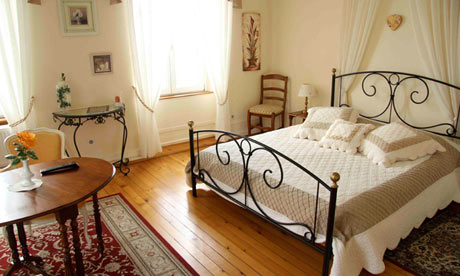
Martine and Alphonse Obry used to run the local bakery here, and now they pamper guests in this beautifully renovated 17th-century farmhouse, whose tower was once part of the village’s ramparts. There are stunning views out over the vineyards, stretching as far as the Black Forest, and the hearty breakfast features local cheeses, homemade jams and Alphonse’s delicious Alsatian pastries, like the kugelhopf. Martine gives excellent advice on local winemakers to visit, and the one not to miss is Domaine Becker (vinsbecker.com), two minutes down the road. Martine Becker is the 13th generation to make wine here, and the convivial tasting room is more like a busy winstube, a cosy mix between a winebar, bistro and pub. Call in advance and she can organise trips to the vineyards. Her organic wines are a bargain, ranging from a litre of the basic edelzwicker, a blend of different grapes, at €5.40 – perfect for a picnic – to €13 for an elegant grand cru riesling or gewürztraminer.
• 46 rue du Schlossberg, Zellenberg, +33 3 8947 9568, clos-froehn.com, doubles €70 with breakfast
Vignoble Klur
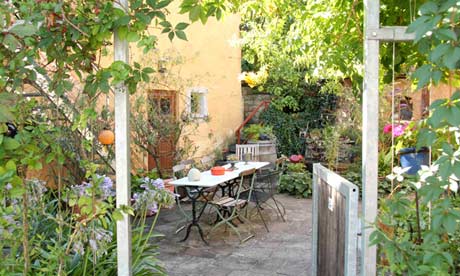
Clément Klur is one of the leading winemakers in Alsace and has been just as innovative in this exciting B&B. Klur wants guests to really understand his wines, and has built roomy appartments with kitchens, asking for a three-night minimum to really experience staying with a winemaker. His outstanding wines are biodynamic – one step beyond organic – with a natural sparkling crémant that contains no sulphates at all. Apart from wine tastings and explanations of the techniques and daily life behind biodynamic cultivation, a stay here can include trekking or biking through the vineyards, culinary workshops, and even poetry and musical evenings. Rather than a chlorine pool, he has built an eco-friendly freshwater pond for swimming, surrounded by a wild garden, a kids’ adventure playground and sauna.
• 105 rue des Trois Epis, Katzenthal, +33 3 8980 9429, klur.net, double room for three nights, no breakfast, €270
WINE VILLAGES
Saint-Hippolyte
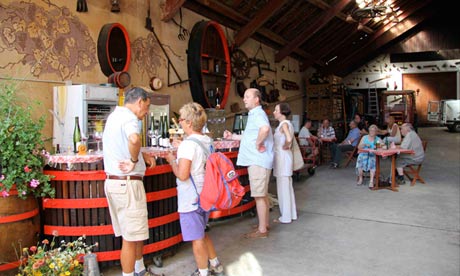
The wine route stretches a total of 170km passing 100 gorgeous villages, many of them with colourful Alsatian half-timbered houses, medieval ramparts and castles, and rolling vineyards. Many can seem just too idyllic to be true – Riquewihr, Kaysersberg, Ribeauvillé, Turckheim, Eguisheim – but with the popularity, comes the inevitable crowds. So when it comes to choosing a place to stay or for a meal, a smaller, less-known village can be a better choice. Saint-Hippolyte is a sleepy hamlet dating back to the time of Charlemagne and is dominated by Alsace’s most grandiose castle, Haut-Koenigsbourg, that sits majestically 700 metres on high. Stay with the friendly viticultrice, Sylvie Fahrer (fahrer-sylvie.com, €55 double room with breakfast), who holds wine tastings in a converted barn filled with giant barrels and tractors. Try the rouge de Saint Hippolyte, a local grape variety that is slightly more full-bodied than the classic Alsatian pinot noir.
Bergheim
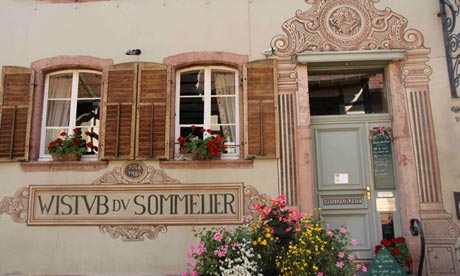
Bergheim is one of the few villages to have almost completely preserved its town walls that date back to the Middle Ages, and you still enter through the arch of an imposing fortified tower. The half-timbered houses are painted a riot of bright colours, and have changed little since the 15th century when many were originally built by wine growers. Book a meal here at the smart Wistub du Sommelier (wistub-du-sommelier.com), where the wine is treated as importantly as the cuisine. Housed in a grand 18th-century mansion, you can feast off a €40 five-course meal, but the real star here is the wine list, one of the most extensive you’ll find on the wine route, with several pages devoted just to the winemakers of Bergheim, and prices that are only a little more than those charged directly by the vigneron.
LOCAL BISTROTS
Caveau Morakopf
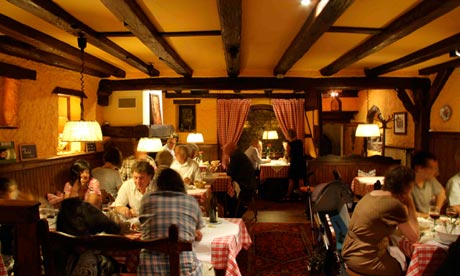
The wines of Alsace are inextricably linked with the unique cuisine of this region – pinot gris vendanges tardives with locally made foie gras, a crisp riesling and a classic choucroute loaded with tasty sausages, river fish such as trout or pike-perch complemented by a light sylvaner or pinot blanc. Every village has its local winstube, and if you choose an off-the-beaten track hamlet such as Niedermorschwihr, you can discover a jewel like the Caveau Morakopf, still filled with locals rather than tourists. Be sure to have a good appetite as portions are enormous, especially the succulent “jambonneau”, pork knuckle, served on a steaming bed of choucroute, veal tripes braised in riesling, or if you order in advance, the traditional baeckeoffe, a hearty stew of mutton, beef, pork and vegetables slow-cooked for 24 hours.
• 7 rue des Trois Epis, Niedermorschwihr, +33 3 8927 0510, caveaumorakopf, main dishes €15-17
Flamme & Co
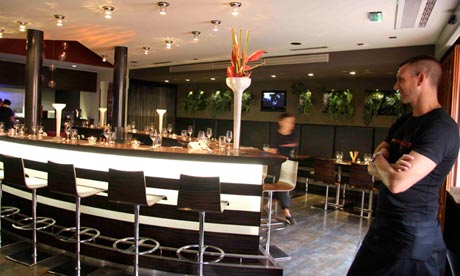
Kaysersberg is one of Alsace’s most breathtakingly beautiful villages, teeming with visitors, and although there are a dozen winstube and bistros to choose from, it is also the location for one of the most surprising eateries on the route. Michelin-starred chef, Olivier Nasti, cooks expensive gourmet cuisine in Le Chambard, but across the road he has opened hi-tech diner Flamme & Co, dedicated to the favourite dish of all Alsatians, the flammekueche or tarte flambée. Served everywhere as a pizza-like aperitif, Nasti has recreated this simple flatbread, cooked in a wood-fire oven, which is usually covered with fromage blanc and then tasty chunks of bacon. The delicious tarts are topped with foie gras and tender magret de canard, scampi, scallops and wok-fried vegetables, or cured ham, parmesan and sundried tomatoes.
• 4 rue du General de Gaulle, Kaysersberg, +33 3 8947 1616, flammeandco.fr, only open in the evening, main dish €10-15
REGIONAL SPECIALITIES
Ferme-auberge du Kahlenwasen
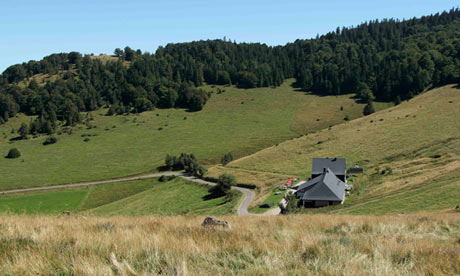
Alsace may not have as many cheeses as most French regions, but the wonderfully pungent Munster stands out, and a half-hour drive off the route into the Vosges mountains to discover the artisan fermes-auberges that make this cheese is an unforgettable sidetrip. From the wine village of Turckheim take the road to Munster itself, then branch left to Luttenbach. A breathtaking narrow road winds up though pine-covered slopes till at 1500 metres you come out by a stark plateau where the Lochert family farm stands with their distinctive Vosgienne cows. While Guy Lochert makes the cheese fresh each morning and shepherds the herd, his wife Marielle cooks for the auberge where you can have lunch or dinner and stay the night in simple accommodation. The menu is limited but utterly mouthwatering, with everything from the farm: vegetable soup, home-cured charcuterie and smoked meat, potatoes fried with bacon, and a fabulous dessert of fresh, milky Munster made that morning swimming in home-brewed kirsch brandy.
• Luttenbach, +33 3 8977 3249, no website, main dish €7-10
Distillerie Miclo
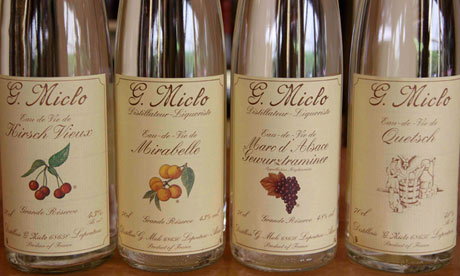
Alsace is just as famous for its fiery distilled alcohols as its wine, and just after the vineyards of Kaysersberg, the tiny village of Lapoutroie boasts the region’s biggest distillery and also the fun Musée des Eaux-de-Vie (musee-eaux-de-vie.com). While most winemakers here sell their own ‘marc‘, the Alsatian take on grappa, the distilleries specialise more in fruit brandies – pear, plum, cherry, wild rasberry, and the more exotic holly berry, hop flower, juniper and even ‘pain d’épices’, spicy gingerbread. The fruits are distilled in Heath Robinson-like alambics, but unlike Cognac or Armagnac, the Alsace tradition does not include oak-barelling, so the alcohol remains crystal-clear. Miclo run a free guided tour Monday-Friday at 4.30pm, while the museum also explains some of the mysteries of absinthe. Both places provide free tastings but don’t forget these fruity digestifs are 45° proof.
• 311 La Gayire, Lapoutroie, +33 3 8947 5016, distillerie-miclo.com
guardian.co.uk © Guardian News & Media Limited 2010
Published via the Guardian News Feed plugin for WordPress.

